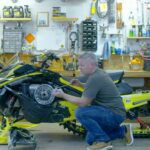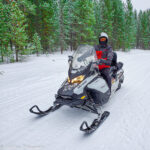Ever ventured out to enjoy the snowy trails and been abruptly brought to a standstill by a broken snowmobile belt? It’s not an uncommon issue. This article focuses on providing insight into what might be causing your snowmobile belt to fail, from improper installation and alignment issues to misuse and negligence of maintenance. The idea is to help you understand the factors responsible, so you’re better prepared to prevent this annoying interruption to your winter leisure.
Understanding Snowmobile Belts
When you first dive into the world of snowmobiling, you might not think much about this seemingly inconsequential part till you’re faced with a breakdown in the middle of an exhilarating ride. That part is your snowmobile belt, a workhorse that keeps your machine moving forward.
Different Types of Belts
You might be surprised to find out that not all snowmobile belts are created equal. There are primarily two types you might encounter, each with its distinct characteristics: the drive belt and the starter belt. The drive belt, as you’d guess, transmits power from your snowmobile’s engine to the tracks, while the starter belt aids in starting your engine when you’re ready to get moving.
The Role of Belts in Snowmobile Operation
Thinking of your snowmobile as a living, breathing organism, then the belt would be its lifeline. The belt facilitates the transfer of power from the engine to the track system, keeping your snowmobile moving in the toughest conditions.
Basic Structure and Composition of Snowmobile Belts
A snowmobile belt is a marvel of engineering, crafted to withstand harsh conditions and deliver consistent performance. These belts are typically made up of a composite of rubber and fabric, creating a durable component that can handle extreme temperatures and rapid shifts in speed.
Common Causes Of Snowmobile Belt Breakage
Sadly, despite their sturdy build, snowmobile belts are not immune to breakage. Some reasons that may necessitate a new belt are a result of overheating, slippage, age, incorrect tension, and use of the wrong belt type for your machine.
Overheating Issues
Keeping your snowmobile belt at an optimum temperature can extend its lifespan. But exposure to excessive heat can lead to premature wear and tear or sudden breakage.
Belt Slippage
This is a common cause of belt issues. Incorrect clutch alignment, loose spring settings, or carrying heavy loads can contribute to your belt slipping off its proper alignment.
Belt Age and Wear
Just like your lucky pair of socks, snowmobile belts deteriorate over time. Regular use, combined with age, can lead to regular wear and tear on your belt.
Incorrect Belt Tension
Too loose, and your belt might slip. Too tight, and you could risk overheating or excessive wear. Achieving the perfect balance is crucial to avoid belt breakage.
Incorrect Belt Selection
Finally, using the wrong belt can spell trouble. The right belt for your snowmobile is dependent on the model and purpose of use. Make sure you select a belt that is suited to your snowmobile and the conditions in which you will be using it.
Overheating Issues
Overheating is a top contender in the causes of belt breakage. But what leads to a belt overheating, you may ask?
The Influence of Speed
Rapid and frequent shifts in speed can lead to excessive heat production, thereby reducing the lifespan of your snowmobile belt.
Lack of Cooling Air
Snowmobile belts rely on air for cooling during operation. Extended operation in conditions where there’s limited cool air will increase your belt’s temperature.
Poorly Ventilated Engine Housing
Belts are cooled passively through the air in your engine compartment. If this air cannot freely circulate, due to blockages or poor design, your belt can overheat.
Impact of Continuous Operation
Just like you, your snowmobile belt needs a break. Continuous operation without sufficient rest periods can elevate your belt’s temperature beyond its tolerance, causing it to deteriorate faster.
Belt Slippage
Belt slippage can be a nagging issue that affects your snowmobile’s performance and can lead to premature belt wear or breakage.
Incorrect Clutch Alignment
An incorrectly aligned clutch can cause your belt to walk off its proper track, leading to possible slippage and eventual breakage.
Loose or Weak Spring Settings
If your belt’s tension springs are too loose or growing weak, this can cause your belt to slip, especially under increased load.
Impact of Heavy Towing or Load
Pulling heavy loads or making use of additional attachments can strain your belt, leading to slippage and faster wear.
Belt Age and Wear
Just like any other part of your snowmobile, belts have a lifespan that is affected by several factors.
Normal Wear and Tear Over Time
Regular use will gradually wear down your belt, which, over time, may lead to a decrease in performance and eventual breakage.
Impact of Continuous Usage
Continuous usage accelerates the wear process, and you might find yourself replacing the belt more often if you are a frequent rider.
Influence of Storage Conditions on Belt life
A frequently overlooked factor that affects a belt’s lifespan is storage conditions. A belt stored in a damp or excessively dry environment can degrade faster, as can belts exposed to extreme temperatures.
Incorrect Belt Tension
Maintaining proper tension levels in your snowmobile belt is very important, as incorrect tension can lead to several issues.
Signs of Incorrect Tension
Some of the signs that your belt may be improperly tensioned include excessive heat, belt slippage, or a decrease in snowmobile power. Paying attention to these signs can save you from a potential belt breakage.
Impact on Belt and Component Operation
A snowmobile belt that is either too tight or too loose can affect your snowmobile’s performance. It can also exert undue stress on other components of your machine, leading to premature wear and tear.
Methods to Adjust Tension
Thankfully, adjusting belt tension is relatively straightforward, requiring only few simple tools and a bit of careful observation. Before doing so, it’s vital to consult your manufacturer’s guide to find the recommended tension for your specific model.
Incorrect Belt Selection
Even with perfect maintenance habits, using the wrong belt for your machine can result in premature breakage.
Understanding Belt Specifications
Before buying a new belt, ensure that you understand your snowmobile’s specific requirements – from the length and width of the belt to its composition and design.
Issues with Snowmobile Performance
Using an incorrect belt can lead to a myriad of performance issues, ranging from reduced power to unpredictable acceleration, and in worst-case scenarios, engine damage.
Ensuring Compatibility with Snowmobile Model
Always make sure that the belt you’re purchasing is compatible with your snowmobile. Using a belt designed for a different model or type of snowmobile can result in premature breakage, or even worse, damage to your machine.
Symptoms of a Failing Snowmobile Belt
It’s crucial to recognize when your belt may be on the brink of failure, as swift action can prevent further damage or even a costly repair bill.
Common Warning Signs
Some common warning signs include reduced power, irregular engine performance, unfamiliar belt noise, a burning smell, or visible damage.
Changes in Snowmobile Performance
Changes in snowmobile performance are typically clear indicators of a failing belt. Such changes may include reduction in speed, inability to climb slopes or poor control during a ride.
Visual Cues That a Belt May Be Failing
Perform regular visual inspections of your belt for any signs of wear, including cracking, fraying, missing pieces, or burns. These tell-tale signs should prompt immediate replacement to prevent further issues.
Preventing Belt Breakage
Belt maintenance requires consistent and proactive attention to keep your snowmobile running smoothly.
Regular Maintenance and Inspection
Routine maintenance and inspections are your best defense against potential belt breakage. Spending a few moments periodically to check your belt for any signs of damage can help you catch any issues before they escalate.
Right Operations and Handling
Proper operation can extend the life of your belt. Avoid abrupt starts and stops, unnecessary high-speed rides, and heavy loads to reduce the strain on your belt.
Choosing the Correct Belt Replacement
Choosing the perfect belt replacement can feel like finding a needle in a haystack. Make sure to refer to your manufacturer’s guidelines during replacement to ensure you’re selecting a belt that’s compatible with your snowmobile.
Conclusion
Importance of Belt Maintenance
Putting in a little effort to understand your snowmobile belt’s role and maintaining it can lead to a smoother ride, longer belt life, and fewer unexpected breaks. Remember, your snowmobile belt is vital to your machine’s performance and your riding experience.
Cost Implications of Neglecting Belt Care
Neglecting your belt can end up costing you in repairs or even a complete replacement. Regularly checking and maintaining your belt is a small price to pay for the peace of mind it brings, and the assurance that you’ll be able to enjoy your ride without any interruptions.
All in all, understanding what causes your snowmobile belt to break is central to preventing it from happening. But remember, sometimes, despite your best efforts, belts break – it’s just part of the game. The key is to stay ahead of it, and not let it catch you (and your ride) by surprise. Happy snowmobiling!
- What Snowboard Bindings Should I Get? - January 23, 2024
- What Size Screws For Snowboard Bindings? - January 23, 2024
- How To Snowmobile On Water? - January 23, 2024










